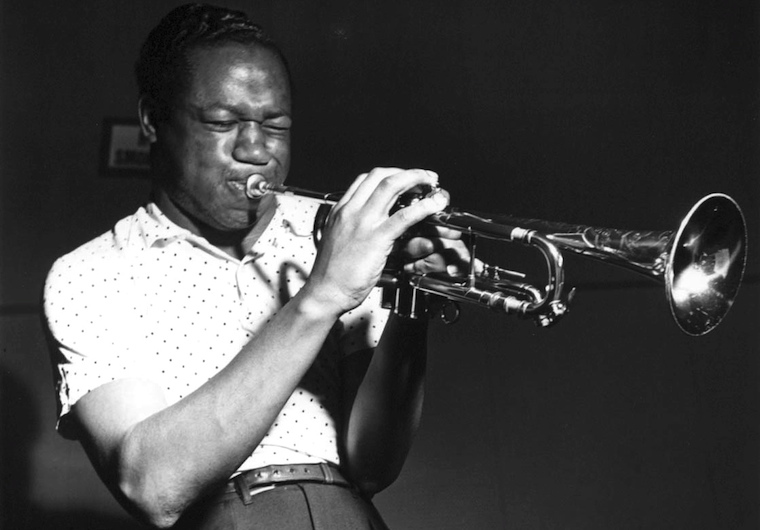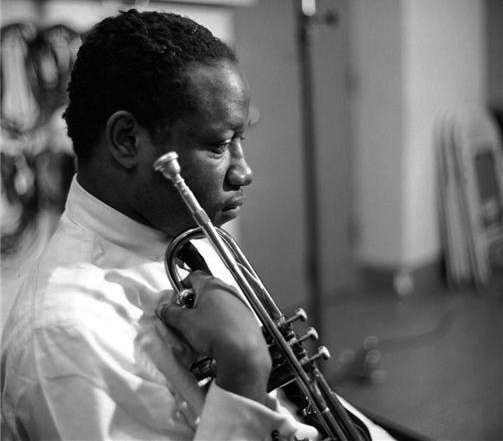
Clifford Brown was born on October 30, 1930 in Wilmington, Delaware and passed away on June 26, 1956 in Bedford, Pennsylvannia.
Brown was the youngest of eight children. Growing up in a musical family, Brown was exposed to music at a young age by his father and older siblings. “From the earliest time,” Brown told Nat Hentoff, “I can remember it was the trumpet that fascinated me. When I was too little to reach it, I would climb up to where it was, and I kept knocking it down.” He received his first trumpet at the age of 13.
Brown began studying with Robert “Boysie” Lowery while in middle school, and soon joined Lowery’s student jazz ensemble, the Little Dukes. He eventually began taking lessons from his high school band director, Harry Andrews, at Howard High School. Andrews exposed Brown to classical trumpet technique, providing him with the foundation for the remarkable technique and control of his mature style. During this time, Brown also began playing the piano and learning basic music theory and arranging skills.
Even before graduating high school, Brown was playing in and around Philadelphia, which was only 27 miles away from Wilmington. Brown began attending Delaware State College in 1948, where he studied mathematics.
Brown sat in for Benny Harris in Dizzy Gillespie’s big band in 1949 during the band’s engagement in Wilmington. Impressed with Brown’s ability, Gillespie encouraged Brown to think about a career in music. After this experience, Brown transferred to Maryland State, receiving a music scholarship and focusing exclusively on music.
On June 6, 1950, Brown is injured in a serious car crash, leaving him with numerous broken bones in his legs and in a full-body cast for several months. While in the hospital, Brown received a visit from Gillespie, who lent him support and again encouraged him to pursue music.
Because of the severity of the accident, Brown was unable to practice trumpet at first and, instead, focused on learning the piano. Eventually, Brown began his trumpet playing anew, deciding to dedicate his efforts towards becoming a professional musician.
In May of 1952, Brown has the opportunity to sit in with Charlie Parker for a week. “Bird helped my morale a great deal,” Brown remembered. “One night he took me in a corner and said, “I don’t believe it. I hear what you’re saying, but I don’t believe it.” Impressed by Brown’s playing, Parker later told drummer Art Blakey that he wouldn’t need a trumpet player before heading to Philadelphia, saying, “You won’t need one after you hear Clifford Brown.”

In Philadelphia, Brown joined Chris Powell and the Blue Flames, a regional rhythm-and-blues group, in the early part of 1952. He made his first recordings with this group on March 21, 1952 for Okeh Records. They recorded four songs, including Ida Red, Blue Boy, Darn That Dream, and I Come from Jamaica.
Brown crossed paths with many jazz-oriented bebop groups while touring with Powell. “I first met Clifford Brown in the spring of ’53 in Philly,” said trumpeter Art Farmer. “He was working with Chris Powell, and I was with Lionel Hampton. When Miles was on the coast in ’51 or ’52, he had told me that I would like Brownie because he was so warm, so I expected him to be good. Well, he exceeded my expectations.”
Brown recorded his first jazz record on June 9, 1953 as a sideman with Lou Donaldson for Blue Note. Among the songs recorded, Brown contributed his own composition “Brownie Speaks.”
“The continuity of his solo line is astonishing,” wrote critic Leonard Feather about Brown’s solos, “placing him at the very top rank of contemporary trumpet stylists.”
Brown soon made several other recordings as a sideman, first with Tadd Dameron’s nine piece group and later with J.J. Johnson, on tunes such as “Turnpike.”
“When Brownie stood up and took his first solos,” recalled critic Ira Gitler, “I nearly fell off my seat in the control room. The power, range, and brilliance together with the warmth and invention was something I hadn’t heard since Fats Navarro.”
Brown became a part of the Lionel Hampton Big Band in July 1953, joining Art Farmer and Quincy Jones in the trumpet section. “I must admit I was more that a bit jealous of his ability to play so well,” Farmer confessed. “However, he was such a sweet and warm human being, I was forced to like him even though he made things very difficult for me as a trumpet player.”
Nearly everyone who knew Brown agree on his likeability and welcoming personality. “To me, the name of Clifford Brown will always remain synonymous with the very essence of musical and moral maturity,” Quincy Jones said. “This name will stand as a symbol of the ideals every your jazz musician should strive to attain.”
Brown recorded his first album as a leader, “The Clifford Brown Sextet,” for Blue Note on August 28, 1953. The group included fellow Hampton band members Gigi Gryce, Percy Heath, and John Lewis as well as tenor saxophonist Charlie Rouse and drummer Art Blakey on tracks such as “Easy Living.”

Following a European tour with Hampton, Brown left the band in the early part of 1954 and briefly played with Art Blakey. After receiving a call from drummer Max Roach in March about starting a group together, Brown moved to Los Angeles, California in March of 1954.
Bridging styles of old (Roach) and new (Brown), the Clifford Brown/Max Roach Quintet is considered the quintessential Hard Bop group, mixing bebop improvisational sensibilities with the forward thinking of a younger generation that grew up playing in rhythm and blues bands. After a month to get themselves together, the quintet first performed in April 1954. The group’s personnel include saxophonist Harold Land, bassist George Morrow, and pianist Richie Powell, the younger brother of Bud Powell.
The Brown/Roach Quintet went into the studio six separate times for EmArcy Records between August 2 and 14, 1954, making many memorable recordings. These include Delilah, Parisian Thoroughfare, Jordu, Joy Spring, and Daahoud.
At the end of 1954, the Brown/Roach Quintet toured extensively, traveling through the cities of New York, Boston, Pittsburgh, Philadelphia, Baltimore, Washington, D.C., St. Louis, Cleveland, Detroit, Chicago, Toronto and several other locations. Enjoying more publicity and greater success, Brown also made recordings with Sarah Vaughan and under his own name with strings, on tracks such as “Lullaby of Birdland ,””Yesterdays,” and “Willow Weep For Me.”
On February 23, 1955, the quintet went into the studio and recorded A Study in Brown, which included their well-known version of “Cherokee” and Brown’s original “Sandu.” “There was camaraderie among the five of us,” said Harold Land, “like a family out there together on the road. Different people said that they could really feel that when we played together, that everything was so tight. This doesn’t usually happen with every group. I think it was because of that closeness and mutual respect that we had a close-knit family.”
In the early 1950s, at a time when jazz players were struggling to find regular gigs, the Brown/Roach Quintet quickly became a powerhouse in the jazz world. This was undoubtedly a direct result of the attitude and business approach of the two co-leaders. “The club owners want to lure stars,” Brown explained, “but try and save money by putting in a local rhythm section. Max and I have had offers while in New York to headline as singles in a couple of places. But unless they hire the unit as it is, we won’t do it. That’s the only way we’re going to keep together. We’ve got to work together all the time.”
On September 30, 1955, the group appeared at the Bee Hive in Chicago, drawing such a crowd that they appeared for six weeks instead of the scheduled two. “I feel as if I just had acid thrown in my face,” Brown told a friend one night during a set break. “My lips are on fire. Sometimes I wonder if I can keep up with Max when he really gets that cymbal going.” During this historical performance, saxophonist Sonny Rollins replaced the departed Harold Land. Rollins was recovering from his own battle with drugs and Brown’s unblemished life style was an inspiration. “Clifford was a profound influence on my personal life,” Rollins admitted. “He showed me that it was possible to live a good, clean life and still be a good jazz musician.”
On June 26, 1956, Brown, Richie Powell and Powell’s wife Nancy were driving from Philadelphia to Chicago for the band’s next appearance. While on the Pennsylvania Turnpike, Nancy lost control of the car on a wet stretch of road a few miles west of Bedford. The car hit a bridge abutment, jumped the barrier and rolled down a seventy-five-foot embankment. All three passengers were killed instantly.
Gentle in person, powerful with his horn, Brown’s legacy goes far beyond his playing on the bandstand. His refusal to use drugs and to support a clean way of living offered a different image of the jazz musician at a time when heavy drinking and heroin use was a common part of being a jazz musician. Most impressive, was what a rich contribution Brown had during his relatively short time in the spotlight. As Sonny Rollins said, “He was just like a shooting star: he’s there and he’s gone.”